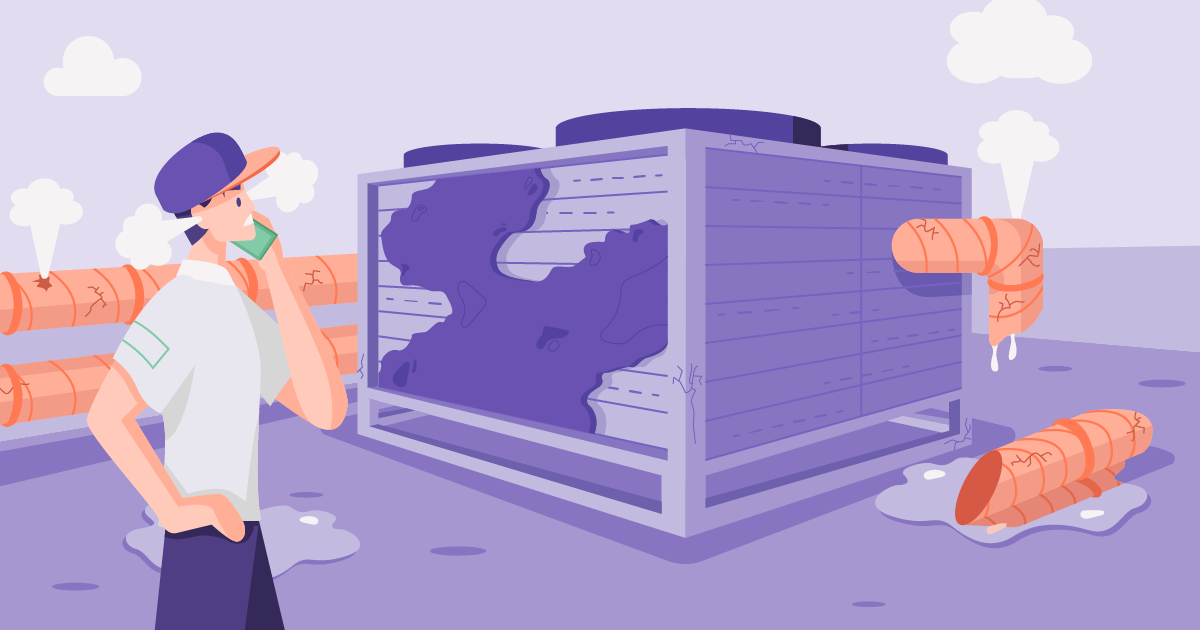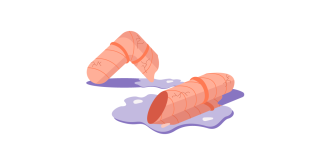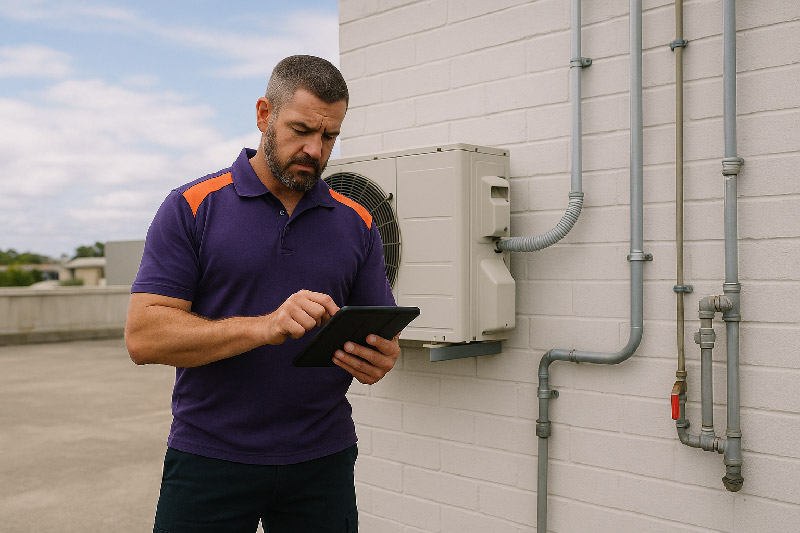Central Heating Maintenance Guide: Ensuring Efficiency and Longevity

Maintaining your central heating system is vital for both its efficiency and longevity. By taking proactive steps to care for your heating system, you can ensure it operates optimally, saving you money on energy bills and avoiding costly repairs.
In this blog post, we’ll delve into the key aspects of central heating maintenance, provide you with helpful tips to keep your system running smoothly, and dive into how commercial HVAC maintenance software can help you.
Summary of Covered Points:
- Understanding Your Central Heating System
- Regular Boiler Maintenance
- Caring for Radiators
- Maintaining the Thermostat
- Importance of Professional Inspections
- Utilizing Field Service Software for Streamlined Maintenance
Understanding Your Central Heating System
Your central heating system consists of various components working together to keep your home warm and comfortable. Understanding these components is key to effective maintenance. Let’s take a closer look at the crucial parts that require routine attention.
Boiler:
The boiler is the heart of your heating system. It heats the water or generates steam that is then distributed throughout your home. Regular boiler maintenance is essential to ensure efficient operation and to prevent breakdowns. This includes checking for leaks, inspecting pressure levels, cleaning or replacing filters, and addressing any unusual noises or odors.
Radiators:
Radiators play a crucial role in distributing heat throughout your home. Regular maintenance involves bleeding the radiators to release trapped air, checking for leaks or corrosion, and ensuring they are not obstructed by furniture or curtains. Proper radiator care improves their efficiency, ensuring even heat distribution and reducing the strain on your boiler.
Thermostat:
The thermostat allows you to control the temperature of your home. To maintain accuracy, it’s important to keep the thermostat clean and free from dust or debris. Check the battery regularly and replace it if needed. Additionally, consider upgrading to a programmable thermostat that enables you to schedule temperature adjustments, optimizing energy usage and comfort.
By understanding the vital components of your central heating system and their role in its operation, you can prioritize their maintenance.
The Importance of Regular Central Heating Maintenance
Regular maintenance is vital for central heating systems, offering these benefits:
- Efficient Operation: Cleaning and inspecting components optimize performance and energy efficiency.
- Extended Lifespan: Promptly addressing issues prolongs the system’s life.
- Cost Savings: Well-maintained systems reduce energy consumption and prevent costly repairs.
- Enhanced Safety: Maintenance ensures the safety of your home by detecting potential hazards.
By prioritizing regular maintenance, you invest in efficient operation, longevity, cost savings, and safety for your central heating system.
Essential Checks for Central Heating Systems
To maintain your central heating and cooling system effectively, regularly perform essential maintenance tasks:
- Air Filter Check: Clean or replace clogged air filters to prevent airflow restrictions and reduced efficiency.
- Flue Inspection: Ensure unobstructed ventilation for safe and efficient operation.
- Refrigerant Levels: Monitor heat pump or AC refrigerant levels within recommended ranges for optimal cooling or heating performance.
- Fan Maintenance: Clean fan blades and motor to maintain airflow and system efficiency.
- Water Pressure: Check and adjust boiler or system water pressure to avoid heating issues or damage.
- Thermostat Calibration: Verify thermostat accuracy and calibration for precise temperature control and energy efficiency.
- Electrical Connections: Inspect and secure electrical connections to prevent malfunctions or hazards.
- Lubrication: Apply lubrication to moving parts like motors or fans to reduce wear and prolong component lifespan.
- Overall Cleaning: Regularly clean system surfaces, including the boiler, radiators, and ductwork, to promote cleanliness and proper airflow.
Always refer to manufacturer guidelines or seek professional assistance for specific maintenance procedures. Performing heating system maintenance regularly helps prevent breakdowns, optimize performance, and ensure a long-lasting central heating system.
The Role of Professional Heating Technicians in Maintenance
When it comes to routine maintenance your HVAC system, the expertise of professional heating technicians plays a vital role. During a maintenance visit, a trained technician will perform a range of tasks to ensure your system is in top-notch condition.
Professional heating technicians will inspect your boiler, checking for any signs of wear or damage. They will clean or replace filters, ensuring optimal airflow and efficiency. Additionally, they will examine the combustion chamber, burners, and heat exchanger to ensure proper operation and identify any potential issues. This is all apart of the maintenance checklist that help maintain peak performance and have significant benefits for your maximum performance systems.
These technicians will also assess the radiators, checking for leaks, corrosion, or cold spots. They will bleed the radiators to remove trapped air, allowing for better heat distribution throughout your home. By entrusting the maintenance tasks to professionals, you can have peace of mind knowing that your home’s heating system is being thoroughly inspected and serviced by experts in the field.
The Significance of Regular System Running and Radiator Bleeding
Regularly running your home’s heating and cooling systems, even during warmer months, is essential for its overall health. By turning it on periodically, you prevent components from seizing up and maintain their functionality. It also helps identify any potential issues before they become major problems.
Bleeding your radiators is another crucial maintenance task. Over time, air can accumulate within the system, leading to reduced efficiency and uneven heating. Bleeding the radiators releases trapped air, allowing hot water or steam to flow freely. This results in better heat distribution and improved system performance.
To perform these tasks effectively, consider the following tips:
- Run your heating system for at least 15 minutes every month, even during summer.
- Make sure all radiators are turned on and heating properly.
- Use a radiator key to bleed the radiators. Open the valve slightly until air stops and water flows consistently. Remember to have a cloth or container to catch any water.
By following these simple maintenance practices, you can enhance the efficiency and longevity of your central heating system.
The Importance of Cleaning and Pressure Checks
Cleaning and pressure checks are integral to maintaining the efficiency of your central heating system. Over time, debris, sediment, or mineral deposits can accumulate within the system, hindering its performance. Regular cleaning helps remove these contaminants, ensuring optimal heat transfer and reducing the risk of breakdowns.
Pressure checks are crucial because the central heating system operates under specific pressure levels. Low pressure can lead to inadequate heating, while high pressure can cause leaks or damage. Monitoring and adjusting the pressure within the recommended range are essential for the system’s proper functioning.
To maintain cleanliness and pressure:
- Clean the system’s components, including the boiler, radiators, and pipes, according to the manufacturer’s guidelines.
- Check the pressure gauge on the boiler regularly and ensure it falls within the recommended range. Consult a professional if you notice any significant deviations.
By incorporating regular cleaning and pressure checks into your asset maintenance routine, you can maximize the efficiency and reliability of your central heating system.
Planning for Upgrades and Replacements
While maintenance can significantly extend the lifespan of your central heating system, there comes a time when upgrades or replacements are necessary. Planning for these changes during the warmer months can offer several benefits.
Firstly, you’ll have ample time to research and explore new heating technologies or more energy-efficient options. Upgrading to a newer system can lead to cost savings on energy bills and provide enhanced comfort.
Secondly, planning ahead allows you to schedule the installation or replacement at your convenience, avoiding the inconvenience of unexpected breakdowns during colder months.
Lastly, during the warmer months, heating technicians are generally less busy, making it easier to schedule appointments and receive prompt service.
By proactively planning for upgrades and replacements, you can make informed decisions and ensure a smooth transition to a more efficient heating system. With a job management system, you can easily keep track of your upcoming maintenance and establish a consistent service checklist for your team.
The Benefits of Annual Central Heating System Service
Annual service for your central heating system is a crucial aspect of maintenance. It offers numerous benefits that contribute to the system’s overall lifespan and performance.
During an annual service, a professional heating technician will perform a comprehensive inspection of your entire system. They will check for any potential issues, clean and lubricate components, and ensure that everything is operating at peak efficiency.
Regular servicing helps identify minor problems before they escalate, reducing the likelihood of unexpected breakdowns and costly repairs. It also improves energy efficiency, which translates to lower utility bills.
Furthermore, an annual service helps maintain manufacturer warranties, ensuring that you’re covered in case of any major malfunctions.
When scheduling an annual service, expect the technician to perform tasks such as:
- Inspecting the boiler, radiators, and pipes for leaks, corrosion, or damage.
- Cleaning and testing key components, such as the burner, heat exchanger, and ignition system.
- Checking the system’s pressure, temperature, and overall performance.
- Verifying the accuracy of the thermostat and adjusting if necessary.
By prioritizing annual central heating system service, you invest in the longevity and reliability of your system, ensuring comfort and peace of mind.
Safety Measures in Central Heating Maintenance
Safety should always be a top priority when performing central heating maintenance. Following proper safety measures not only protects you and your family but also contributes to more effective maintenance outcomes and reduced accident rates.
Here are some key safety practices to consider:
- Before conducting any maintenance tasks, turn off the power supply to the heating system to avoid electric shocks.
- Allow the system to cool down before attempting any work to prevent burns from hot surfaces.
- Use appropriate personal protective equipment (PPE) such as gloves and eye protection when handling cleaning agents or chemicals.
- If you’re uncertain or uncomfortable with any maintenance task, it’s best to seek professional assistance.
- Regularly check for carbon monoxide leaks by installing a carbon monoxide detector and following the manufacturer’s recommendations.
By fostering a safety-conscious culture and adhering to these safety measures, you can ensure the well-being of everyone involved while maintaining your central heating system effectively.
Leveraging FieldInsight for Central Heating Maintenance
Managing central heating maintenance can be simplified and streamlined with the help of FieldInsight, our comprehensive field service software. Here’s how FieldInsight can be instrumental in optimizing your maintenance tasks:
Scheduling and Tracking: FieldInsight allows you to schedule and assign maintenance tasks to your team members with ease. You can track progress, receive real-time updates, and ensure that all tasks are completed on time.
Asset Management: Keep a detailed record of your central heating system assets, including maintenance history, warranties, and important documentation. This centralized asset management feature helps you stay organized and informed.
Reporting and Analytics: FieldInsight provides insightful reports and analytics to help you monitor the performance of your central heating system, identify trends, and make data-driven decisions for maintenance optimization.
Mobile Accessibility: Field technicians can access FieldInsight on their mobile devices, allowing them to view task details, update progress, and access relevant information while on-site.
By leveraging FieldInsight’s powerful features, you can enhance the efficiency and effectiveness of your central heating maintenance, saving time and resources.
Conclusion
By understanding the components of your heating system and performing regular maintenance tasks such as boiler upkeep, radiator bleeding, cleaning, and pressure checks, you can optimize its performance and prevent major issues.
Planning for upgrades and replacements during warmer months provides convenience and allows for careful consideration of energy-efficient options. Additionally, scheduling annual servicing and prioritizing safety measures are crucial steps to protect your investment and maintain a comfortable and safe environment.
Don’t forget to explore FieldInsight as a comprehensive solution for managing your central heating maintenance. Its features, including scheduling, tracking, asset management, and reporting, can streamline your maintenance processes and contribute to the overall efficiency of your operations.
Remember, preventive and scheduled maintenance is key to optimal performance and the longevity of your central heating system. So, start implementing these maintenance practices today and enjoy a warm and cozy home for years to come.
What You Should Do Now
- Book a Demo. You’ll be in touch with an automation expert who has worked in this space for over 5 years, and knows the optimal workflow to address your needs.
- If you’d like access to free articles about managing HVAC workflows, go to our blog.
- If you know someone who’d enjoy reading this page, share it with them via email, Linkedin, Twitter, or Facebook.






